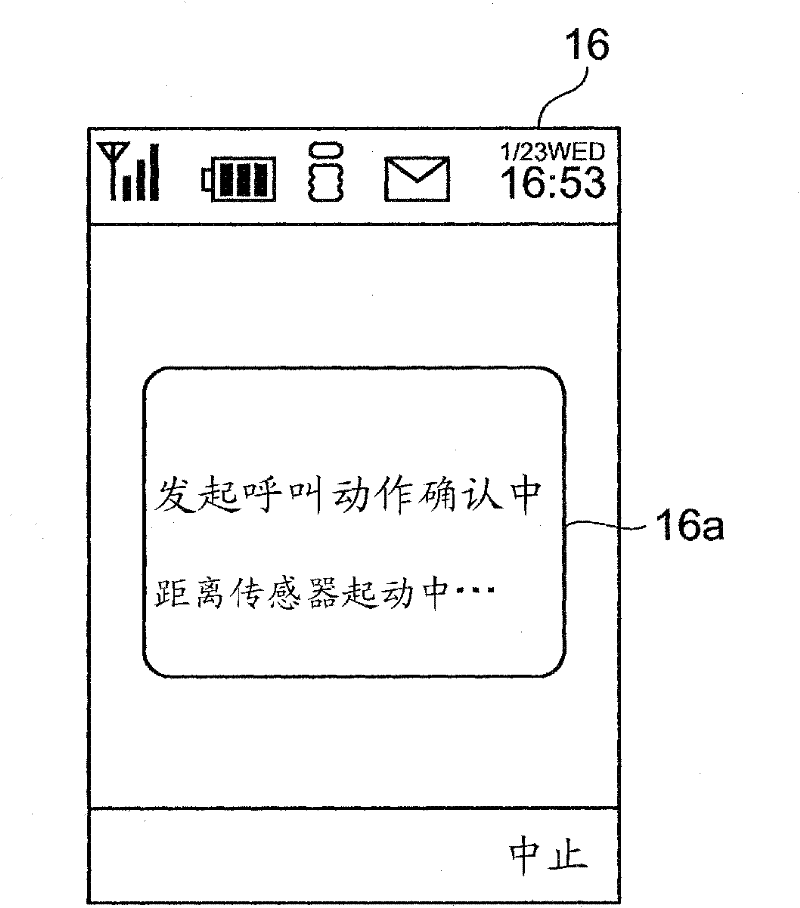Telephone and method of controlling call initiation therein
A technology for initiating calls and telephones, which is applied in telephone structure, telephone communication, and prevention of unauthorized/fraudulent calls, etc. It can solve the problems of failure to prevent false transmissions, sending content to wrong destinations, and false transmissions, etc. question
- Summary
- Abstract
- Description
- Claims
- Application Information
AI Technical Summary
Problems solved by technology
Method used
Image
Examples
no. 1 Embodiment approach
[0022] like figure 1 and figure 2 As shown, the mobile phone 10 according to this embodiment is, for example, a foldable mobile phone including a microphone 12, a speaker 14 (sound output unit) and a display screen 16, and can communicate with other mobile phones M via a wireless network NW. call in between. The microphone 12 is a device for inputting the voice of the user U to be transmitted to other mobile phones M when talking with other mobile phones M, and the speaker 14 is for outputting voices from other mobile phones M when talking with other mobile phones M. The voice of the mobile phone M is transmitted to the device of the user U.
[0023] like figure 2 As shown, the cellular phone 10 functionally includes an input unit 18 , a detection unit 20 (distance detection unit), a determination unit 22 (determination unit), a storage unit 24 , a control unit 26 and a communication unit 28 .
[0024] The input unit 18 is a part for receiving an instruction from the use...
no. 2 Embodiment approach
[0042] Next, a second embodiment of the present invention will be described. The mobile phone 30 in the second embodiment differs from the first embodiment in that Image 6 As shown in (a), the detection unit 20 is constituted by, for example, an acceleration sensor 20b, and the acceleration applied to the mobile phone 30 can be detected by the acceleration sensor 20b. Other structures are basically the same as those of the first embodiment. The following description will focus on differences from the first embodiment.
[0043] The mobile phone 30 functionally includes an input unit 18 , a detection unit 20 (acceleration detection means), a determination unit 22 , a storage unit 24 , a control unit 26 , and a communication unit 28 . The functions of the input unit 18, the control unit 26, and the communication unit 28 are the same as those of the first embodiment.
[0044] The detection unit 20 is constituted by, for example, an acceleration sensor 20 b and is a part for de...
no. 3 Embodiment approach
[0051] Next, a third embodiment of the present invention will be described. The mobile phone 40 in the third embodiment differs from the first embodiment in that Figure 8 As shown in (a), the detection unit 20 is constituted by, for example, an illuminance sensor 20c, and the illuminance near the speaker 14 of the cellular phone 40 can be detected by the illuminance sensor 20c. Other structures are basically the same as those of the first embodiment. The following description will focus on differences from the first embodiment.
[0052] The mobile phone 40 functionally includes an input unit 18 , a detection unit 20 (illuminance detection means), a determination unit 22 , a storage unit 24 , a control unit 26 , and a communication unit 28 . The functions of the input unit 18, the control unit 26, and the communication unit 28 are the same as those of the first embodiment.
[0053] The detection unit 20 is constituted by, for example, an illuminance sensor 20 c and is a por...
PUM
 Login to View More
Login to View More Abstract
Description
Claims
Application Information
 Login to View More
Login to View More - R&D
- Intellectual Property
- Life Sciences
- Materials
- Tech Scout
- Unparalleled Data Quality
- Higher Quality Content
- 60% Fewer Hallucinations
Browse by: Latest US Patents, China's latest patents, Technical Efficacy Thesaurus, Application Domain, Technology Topic, Popular Technical Reports.
© 2025 PatSnap. All rights reserved.Legal|Privacy policy|Modern Slavery Act Transparency Statement|Sitemap|About US| Contact US: help@patsnap.com



